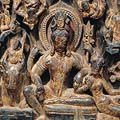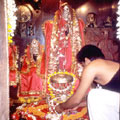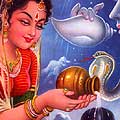|
|
 |
 |
| Modes of Interaction with the Deity: Puja and Darshan |
|
|
Within the Hindu religious context, the devotee's experience and interpretation of an object are inextricably linked to the concept of darshan -- "sight." As the historian of religion Diana Eck of Harvard University argued in her groundbreaking study Darsan: Seeing the Divine Image in India, the act of seeing is "the central act of Hindu worship." It is the primary means by which the worshiper interacts with and experiences the deity embodied in an image (murti) (Figure 1).
Darshan is a physical act, and a moment of exchange between the viewer and viewed: the devotee both sees and is seen by the deity, usually in the form of a sacred image (see Video clip: Darshan). By viewing the divine, one performs worship, and it is through the eyes that one gains the blessings of God. The rituals associated with the worship of an image, known by the general term puja -- including the interaction with the deity through the physical act of seeing -- depend on the divine, or some key aspect of it, being fully present within the image itself. This is brought about through a complicated process culminating in consecration, which is the means by which the image is enlivened with the deity's presence and its eyes are ritually opened. The eyes are often the most prominent feature of a devotional image (Figure 2), and even non-anthropomorphic images are sometimes adorned with eyes.
Essentially, the complex rituals that comprise puja represent the act of welcoming the deity as an important guest, and entertaining him or her as one would a beloved and honored person. The sights and sounds associated with puja are striking, and contribute to the joyful celebration of the senses experienced in any Hindu temple, whether in New Delhi or in New Jersey (see Video clip: Puja). Bells are rung to awaken the deity, and excerpts from sacred texts are recited in incense-scented rooms. Images are often dressed in fine silks, flowers, and jewelry that may completely cover the figure underneath: the beauty of the images themselves honors God, as do the elaborate adornments that garb them (Figure 3). In most Hindu temples the patterns of the day are echoed in the patterns of worship, a schedule according to which the deity is treated to honorable and reverential service. The term puja can also refer to whole festivals: the Durga Puja held yearly in Bengal, for example, encompasses many different individual and community-wide acts of puja and celebrations, all part of a nine-day-long public celebration of the Goddess.
Images thus embody divinity, and the Gods are worshiped through interaction with and care of their images (Figure 4). Such images bear other meanings in the devotional environment, and relate to a broad range of practices. Images help to tell the tales that describe and honor the Gods, and offer a focus for meditation. The embodiment and representation of divinity relates to other forms of divinization, such as ritual possession and yogic and other practices that transform human beings into conduits and containers for the divine. Nevertheless, the importance and validity of the image as a representation and embodiment of God has been challenged for centuries. In the 8th century, the great philosopher Shankaracarya granted some validity to the worship of images, but considered it a "lower" form of religious life. In early-20th-century India, proponents of Sanatan Dharm defended the worship of images against criticism by other Hindus and outsiders. The ubiquitous presence of devotional images in the temples of South and Southeast Asia and their diaspora communities attests to their importance and continued relevance for worshipers today.
< previous next >
Top |
|
 |
 |
| Click for details |
 |
 |
 |
Fig. 1
|
 |
 |
 |
Fig. 2
|
 |
 |
 |
Fig. 3
|
 |
 |
 |
Fig. 4
|
 |
|
 |


